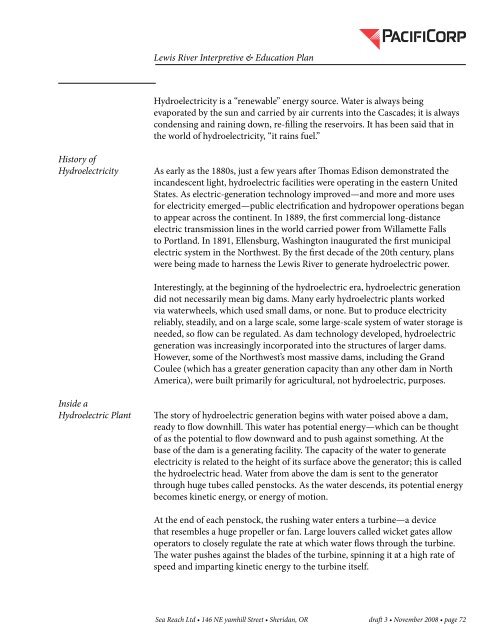The Lewis River Hydroelectric Projects - PacifiCorp
The Lewis River Hydroelectric Projects - PacifiCorp
The Lewis River Hydroelectric Projects - PacifiCorp
You also want an ePaper? Increase the reach of your titles
YUMPU automatically turns print PDFs into web optimized ePapers that Google loves.
<strong>Lewis</strong> <strong>River</strong> Interpretive & Education Plan<br />
<strong>Hydroelectric</strong>ity is a “renewable” energy source. Water is always being<br />
evaporated by the sun and carried by air currents into the Cascades; it is always<br />
condensing and raining down, re-filling the reservoirs. It has been said that in<br />
the world of hydroelectricity, “it rains fuel.”<br />
History of<br />
<strong>Hydroelectric</strong>ity<br />
As early as the 1880s, just a few years after Thomas Edison demonstrated the<br />
incandescent light, hydroelectric facilities were operating in the eastern United<br />
States. As electric-generation technology improved—and more and more uses<br />
for electricity emerged—public electrification and hydropower operations began<br />
to appear across the continent. In 1889, the first commercial long-distance<br />
electric transmission lines in the world carried power from Willamette Falls<br />
to Portland. In 1891, Ellensburg, Washington inaugurated the first municipal<br />
electric system in the Northwest. By the first decade of the 20th century, plans<br />
were being made to harness the <strong>Lewis</strong> <strong>River</strong> to generate hydroelectric power.<br />
Interestingly, at the beginning of the hydroelectric era, hydroelectric generation<br />
did not necessarily mean big dams. Many early hydroelectric plants worked<br />
via waterwheels, which used small dams, or none. But to produce electricity<br />
reliably, steadily, and on a large scale, some large-scale system of water storage is<br />
needed, so flow can be regulated. As dam technology developed, hydroelectric<br />
generation was increasingly incorporated into the structures of larger dams.<br />
However, some of the Northwest’s most massive dams, including the Grand<br />
Coulee (which has a greater generation capacity than any other dam in North<br />
America), were built primarily for agricultural, not hydroelectric, purposes.<br />
Inside a<br />
<strong>Hydroelectric</strong> Plant<br />
<strong>The</strong> story of hydroelectric generation begins with water poised above a dam,<br />
ready to flow downhill. This water has potential energy—which can be thought<br />
of as the potential to flow downward and to push against something. At the<br />
base of the dam is a generating facility. <strong>The</strong> capacity of the water to generate<br />
electricity is related to the height of its surface above the generator; this is called<br />
the hydroelectric head. Water from above the dam is sent to the generator<br />
through huge tubes called penstocks. As the water descends, its potential energy<br />
becomes kinetic energy, or energy of motion.<br />
At the end of each penstock, the rushing water enters a turbine—a device<br />
that resembles a huge propeller or fan. Large louvers called wicket gates allow<br />
operators to closely regulate the rate at which water flows through the turbine.<br />
<strong>The</strong> water pushes against the blades of the turbine, spinning it at a high rate of<br />
speed and imparting kinetic energy to the turbine itself.<br />
Sea Reach Ltd • 146 NE yamhill Street • Sheridan, OR draft 3 • November 2008 • page 72
















